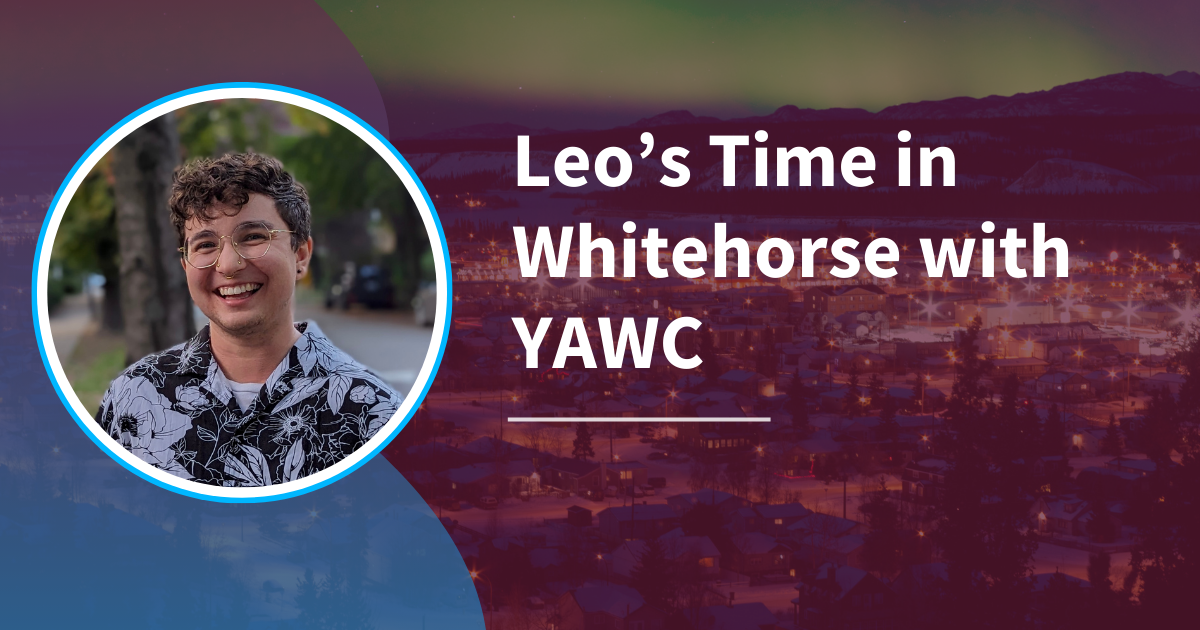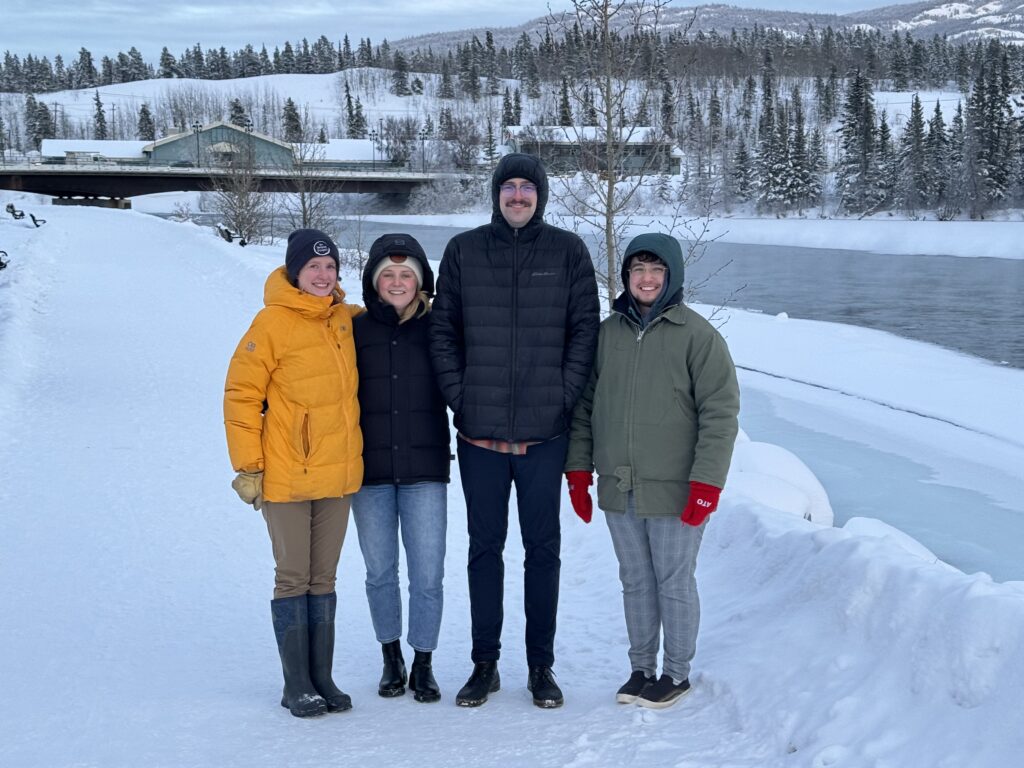Leo’s Time in Whitehorse with the Yukon Aboriginal Women’s Council










On behalf of Strategies North, I’d like to extend a big congratulations to our client, the Yukon Aboriginal Women’s Council (YAWC), who just celebrated their 50th Anniversary! Over the past couple of months, I’ve traveled to Whitehorse, YT twice to work on projects with the council and other members of the SN team. Visiting the city for work was an exciting opportunity professionally, as it was my first time traveling for work, and personally, as it was the furthest North I’d ever been. I’ve lived in Vancouver now for 8 years, but I grew up in the prairies of Saskatchewan and felt well-equipped to handle whatever winter weather we faced. On my second visit to Whitehorse, temperatures got a little frigid, dropping below -20, but during the first trip, it was unseasonably warm, barely reaching -10 most days.
Whitehorse and the surrounding lands are beautiful. The small city is somewhat spread out, consisting of small neighbourhoods along the Alaska Highway, a layout described as ‘pearls on a string’ in a brochure I read. The language might be a little fluffy for the hearty city, but I understand the comparison. Whitehorse’s downtown, where we spent most of our time working, is quite compact and conveniently located adjacent to the airport, but getting to another neighbourhood requires driving, transit, or biking. I was only somewhat surprised to see the occasional cyclist trekking around during our trips – if people can brave the endless pouring rain in Vancouver, why not the crisp bite of Whitehorse winter?
Since beginning at Strategies North, YAWC has been the client I’ve worked with most extensively. At times we were even having weekly video meetings with the entire staff, so I already felt like I had really built relationships with everyone, but it was completely different to meet in person – for one, I was shorter than everyone expected, which I’m going to take as a compliment? The main work I’ve done for YAWC is writing funding proposals, which I would have thought could be completely supported by reading extensively on the organization’s background, emailing program managers, and having short video calls. In reality, getting to talk with everyone about their programs in person, tour the office space, and be in Whitehorse, fundamentally shifted (and improved) the way I wrote their applications. I gained so much information and insight, but I also felt more connected to YAWC’s goals in a way that just made everything easier to write.
My first trip to Whitehorse overlapped with the National Day of Remembrance and Action on Violence Against Women, on December 6th. The three of us from SN, CEO Anna Barley, Operations Advisor Lauren McIvor, and myself, went with some of the YAWC staff to a vigil held in the Kwanlin Dün First Nation village, hosted by the Victoria Faulkner Women’s Centre. Whitehorse sits in the territory of Kwanlin Dün First Nation and Ta’an Kwäch’än Council, and ‘the village’ is one of those ‘pearls’ linked to Whitehorse. The vigil was held outside around a sacred fire, and attended by a wide array of people. There were others from Whitehorse non-profits, Elders, Kwanlin Dün Nation members, women working in various sectors, and a large number of male and female engineers. The Action on Violence Against Women Day recognizes the murder of 14 young women, mainly engineering students, at Polytechnique Montréal on December 6, 1989. The massacre remains one of the deadliest mass shootings in Canada’s history.
The vigil was unlike any commemorative event I’ve attended. A Kwanlin Dün member gave everyone the opportunity to smudge before the ceremony started, while a local fiddle musician played warm but somber songs. Once we began every person in the circle had the opportunity to share their name, and why they were at the vigil. This stirred up some social anxiety for me at first, but doing so ultimately felt like an act of accountability and care, and I still remember so many of the other participants’ responses. Similarly, the act of us putting sacred medicines in the fire to burn made it feel unexpectedly personal, and remind me of the responsibility I have as a white and queer guy to dismantle the misogyny I see in my own life. The vigil ended with the passing out of 14 white roses to represent the women whose lives were lost on December 6, 1989, and 45 red roses to represent the Missing and Murdered Indigenous Women and Girls of the Yukon. The roses were such a simple act, but watching them get individually distributed to attendees really sunk home the reality of the person behind the statistic. Driving back to our temporary home that night, holding a red rose, I wondered about, and felt grief for, the person it represented, and the family and community missing her.
Who is YAWC?
YAWC began as the Yukon Indian Women’s Association on January 21, 1974, when a group of women rallied together around a common interest of improving the welfare and voice of Indigenous women of the Yukon. The first meeting at the Skookum Jim Friendship Centre was held by Lorraine Joe, Margaret Commodore (née Joe), Frances Woolsey, Josephine Muff, Patt Delaney, Kathy Rear, Pat Martin, Maxine Grant, Emma (Kaushee) Harris, and Edi Bohmer. For years the group worked without a dedicated space, often meeting around campfires and kitchen tables. One of YAWC’s earliest political actions was in 1980 when several members traveled to Ottawa to protest the removal of an Indigenous woman’s legal “Indian status” if she married a non-Indigenous man. This discriminatory law resulted in thousands of women being unable to secure status under the Indian Act for themselves and their children. Pressure on the federal government eventually resulted in the passing of Bill-C31 in 1986, effectively protecting status rights for women and their children. YAWC has had many notable alumni over the years, including Brenda Sam, who would go on to be elected to council and eventually Chief of Ta’an Kwäch’än Council; Margaret Commodore, a founding YAWC member who became the first female Indigenous Justice Minister in Canada; Kaushee Harris, another founder who is commemorated for her advocacy for Indigenous Yukon women with the Yukon Women’s Transition Home, which is named Kaushee’s Place in her honour; Margaret Thompson, who went on to become president of the Native Women’s Association of Canada; and Alice McGuire, who was the first female Yukon First Nations member of the Yukon Legislative Assembly.
Today YAWC supports Indigenous women, girls, and gender diverse people and their families across the 17 First Nations of Yukon and Northern BC, and the urban Indigenous population in Whitehorse. YAWC’s programs include the MMIWG Outreach Program for families of Missing and Murdered Indigenous Women and Girls; the Indigenous Skills and Employment Training program and supplementary Life Skills initiative; cultural well-being and emotional support through their Elders-in-Residence and Counselors-in-Residence; and free hot meals three days a week through the Sally & Sisters/Soeurs Lunch program, as well as countless other projects and research initiatives. YAWC has established itself as a trusted resource for Indigenous women and their families and is constantly building bridges with other service agencies and governments to achieve the best possible outcomes for those they serve. Getting to work with YAWC to secure funding for their programming and new projects is one of the most meaningful aspects of my job, and I’m delighted to support all of the amazing women working there; Susie Ross, Client and Program Coordinator; Darlene Skookum, ISET Coordinator; Joy O’Brien, MMIWG Outreach Coordinator; Roseanna Leonard, Receptionist (/Office and Logistics Maven); Sally & Sisters Coordinator Sue Carlick; Program Support Specialist Ellen Kyikavichiik, and President Terri Szabo, as well as the incredible Board Members, Elders, Counselors, and volunteers who make it all happen.